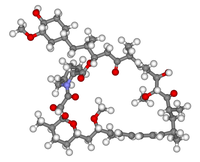
Photo from wikipedia
The mutations at the hotspot region of K‐Ras result in the progression of cancer types. Our study aimed to explore the small molecule inhibitors against the G13D mutant K‐Ras model… Click to show full abstract
The mutations at the hotspot region of K‐Ras result in the progression of cancer types. Our study aimed to explore the small molecule inhibitors against the G13D mutant K‐Ras model with anti‐cancerous activity from food and drug administration (FDA)‐approved drug compounds. We implemented several computational strategies such as pharmacophore‐based virtual screening, molecular docking, absorption, distribution, metabolism and excretion features, and molecular simulation to ensure the identified hit compounds have potential efficacy against G13D K‐Ras. We found that the FDA‐approved compounds, namely, azelastine, dihydrocodeine, paroxetine, and tramadol, are potential candidates to inhibit the action of G13D mutant K‐Ras. All four compounds exhibited similar binding patterns of sotorasib, and a structural binding mechanism with significant hydrophobic contacts. The descriptor features from the QikProp of all four compounds are within allowable limits compared to sotorasib drug. Consequently, a molecular simulation result emphasized that the dihydrocodeine and tramadol exhibited less fluctuation, minimal basin, significant h‐bonds, and potent inhibition against G13D K‐Ras. As a result, the current research identifies prospective K‐Ras inhibitors that could be further improved with biochemical analysis for precision medicine against K‐Ras‐driven cancers.
Journal Title: Journal of Cellular Biochemistry
Year Published: 2022
Link to full text (if available)
Share on Social Media: Sign Up to like & get
recommendations!